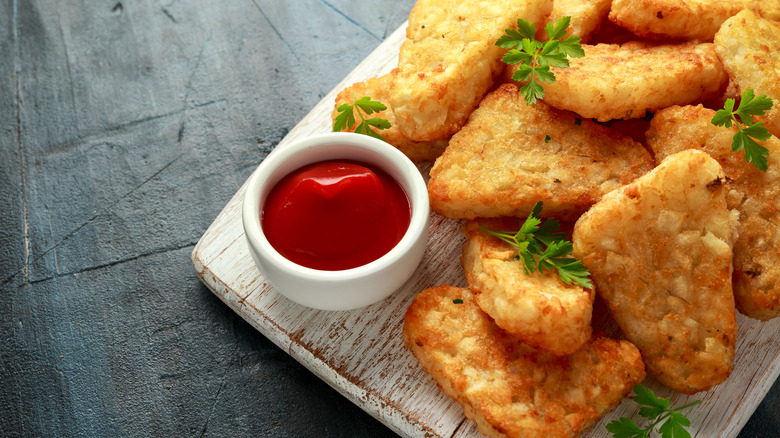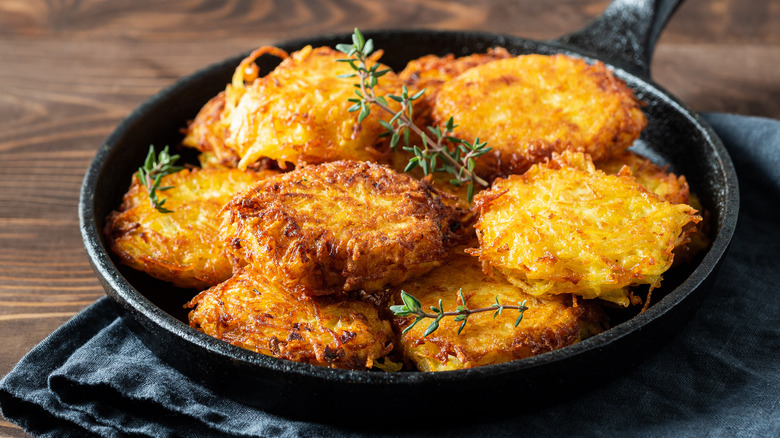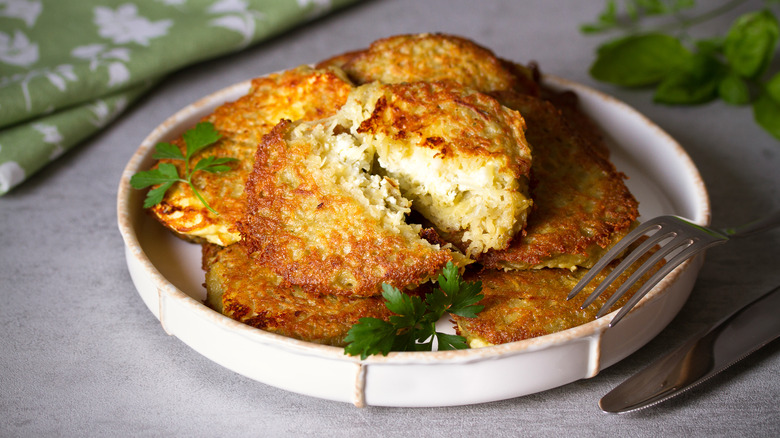The Hazy Origin Of Hash Browns
If you prefer your breakfast on the savory side, the odds of you enjoying hash browns are pretty great. These crispy shredded potatoes are often flavored with minced onion and served alongside eggs cooked to your liking with bacon or sausage. They come frozen in bags at the grocery store for easy assembly but can taste divine when made from scratch. However, you may like yours a certain way, as they often come in different shapes and styles.
According to The Kitchn, hash browns can be prepared in four ways: shredded, patties, country-style, and O'Brien. You know your hash browns are country-style if they're cubed instead of shredded (via Let's Dish), and O'Brien hash browns are country-style but with peppers and onions in the mix (per Saveur). The patties are just shredded potato pancakes, holding their shape in a mold similar to the kind you can get at McDonald's. However, shredded is a tad more versatile, allowing you to shape it into patties or keep it on the griddle for those crispy, evenly cooked edges.
And while some may agree with calling these various forms of the potato "hash browns," Saveur argues that cubed potatoes and O'Brien style go under entirely different categories — O'Brien being just O'Brien with the additional veggies and cubed potatoes as home fries. With these definitions in mind, it's evident that the term "hash browns" can be a bit confusing. And when dating back to its origins, it just gets even more complicated.
Hash browns weren't always named that
According to The Old Foodie, the first mention of any sort of "hash brown" dish occurred in 1835 when the "Minnesota Farmers' Institute Annual" wrote out three different recipes for hash potatoes, brown hashed potatoes, and brown creamed hash potatoes — so it's possible that the Minnesotans are responsible for inventing this idea that potatoes can be cut up and cooked together in a hash form. However, it's believed that food author Maria Parloa was the first to define "hashed brown potatoes" in 1888 in her book "Kitchen Companion: A Guide for All Who Would Be Good Housekeepers" as a "fried mixture of cold boiled potatoes" (via Idaho Potato and Live Naturally Magazine).
Slurrp states that because the term "hash" resembles the French word "hacher," which means to chop or hack, this is most likely how the dish developed its name. Parloa's dish resembled that, and The Old Foodie notes that her version was not shredded. Instead, the potatoes were boiled whole, chopped, pressed into a skillet with butter, and seared into a large cake — pretty similar to that of the Minnesotan way. Then, you'd finish it off in the oven until it browned on the bottom.
From there, hashed brown potatoes made their way onto hotel breakfast menus in New York City due to their increased popularity in the late 1890s, per Erin Nudi. Food Reference states that the term "hashed brown potatoes" was finally shortened and referred to as hash browns by 1970 – although it remains a mystery how or why this transition took place.
Various forms of hash browns grew to be popular
Following their demand, it seems that different types of hash browns began popping up in restaurants — diced, cubed, julienned, or cut up and formed into patties. For the O'Brien style, the idea of putting peppers and pimentos into the mix of cubed potatoes is credited to Beefstew O'Brien, a New York City restaurant owner who wanted to add color to the dish, according to Saveur. And as for the patty version, it's unclear when this type was first created, but brands like Ore Ida have produced them since 1952 (per HyVee), and then McDonald's introduced them on their breakfast menu in 1977 and continues to serve them.
Erin Nudi also claims it's possible that dishes like rösti, a potato pancake from 16th-century Switzerland (via The Nosey Chef), and tortilla de patatas, a potato omelet from Spain, may have served as the inspiration behind hash browns since they resemble them so closely. Basically, much like the term "hash browns" has evolved from "hashed brown potatoes," the dish itself has also changed into various forms somewhere along the line.
Whether or not you agree that any fried blob of cut-up potatoes is technically hash browns considering their hazy past — that's up to you to decide. But one thing is clear: They're bound to be a delicious addition to your breakfast in whichever form you choose.


